How does endodontic treatment save the tooth?
The endodontist removes the inflamed or infected pulp, carefully cleans and shapes the inside of the tooth, then fills and seals the space. Afterwards, you will return to your dentist, who will place a crown or other restoration on the tooth to protect and restore it to full function. After restoration, the tooth continues to function like any other tooth. Turn to pages six and seven for a step-by-step explanation of the procedure.
Will I feel pain during or after the procedure?
Many endodontic procedures arc performed to relieve the pain of toothaches caused by pulp inflammation or infection. With modern techniques and anesthetics, most patients report that they are comfortable during the procedure.
For the first few days after treatment, your tooth may feel sensitive, especially if there was pain or infection before the procedure. This discomfort can be relieved with over-the-counter or prescription medications. Follow your endodonlisl’s instructions carefully.
Your tooth may continue to feel slightly different from your other teeth for some time after your endodontic treatment is completed. However, if you have severe pain or pressure or pain that lasts more than a few days, call us.
Endodontic Procedure
Endodontic treatment can often be performed in one or two visits and involves the following steps:
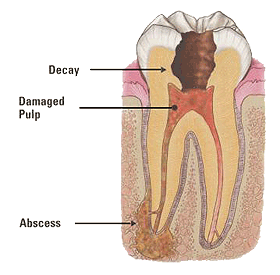 1.The endodontist examines and x-rays the tooth, then local anesthetic. After the tooth is numb, the endodontist places a small protective sheet called a “dental dam” over the area free of saliva during the procedure.
1.The endodontist examines and x-rays the tooth, then local anesthetic. After the tooth is numb, the endodontist places a small protective sheet called a “dental dam” over the area free of saliva during the procedure.
2.The endodontist makes an opening in the crown of the tooth.Very small instruments are used to clean the pulp from the pulp chamber and root canals and to shape the space for filling.
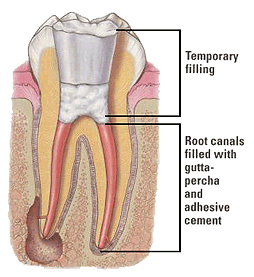 3.After the space is cleaned and shaped, the endodontist fills the root canals with a biocompatible material, usually a rubber-like material called “gutta-percha.” The gutta-percha is placed with an adhesive cement to ensure complete scaling or the- root canals. In most cases, a temporary filling is placed to close the opening.The temporary filling will be removed by your dentist before the tooth is restored.
3.After the space is cleaned and shaped, the endodontist fills the root canals with a biocompatible material, usually a rubber-like material called “gutta-percha.” The gutta-percha is placed with an adhesive cement to ensure complete scaling or the- root canals. In most cases, a temporary filling is placed to close the opening.The temporary filling will be removed by your dentist before the tooth is restored.
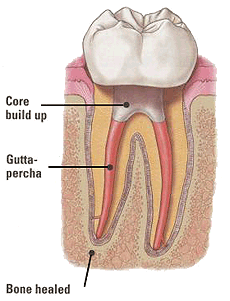 4.After the final visit with your endodontist, you must return to your dentist to have a crown or other restoration placed on the tooth to protect and restore it to full function.
4.After the final visit with your endodontist, you must return to your dentist to have a crown or other restoration placed on the tooth to protect and restore it to full function.
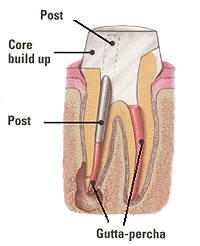 If the tooth lacks sufficient structure to place, we place a post inside the tooth. Ask your dentist or endodontist for more details about the specific restoration planned for your tooth.
If the tooth lacks sufficient structure to place, we place a post inside the tooth. Ask your dentist or endodontist for more details about the specific restoration planned for your tooth.
How much will the procedure cost?
The cost varies depending on how severe the problem is and which tooth is. affected. Molars are more difficult to rival and usually cost more. Most dental insurance policies provide coverage for endodontic treatment.
Generally, endodontic treatment and restoration of the natural tooth are less expensive than the alternative of having the tooth extracted. An extracted tooth must be replaced with a bridge or implant to restore chewing function and prevent adjacent teeth from shifting. These procedures tend to cost more than endodontic treatment and appropriate restoration.
Will the tooth need any special care or additional treatment?
You should not chew or bite on the treated tooth until you have had it restored by your dentist.The unrestored tooth is susceptible to fracture, so you should see your dentist for a full restoration as soon as possible. Otherwise, you need only practice good oral hygiene, including brushing, flossing, and regular checkups and cleanings.
Most endodontically treated teeth last as long as other natural teeth. In a few cases, a tooth that has undergone endodontic treatment fails to heal or the pain continues. Occasionally, the tooth may become painful or diseased months or even years after successful treatment. Often when this happens, another endodontic procedure can save the tooth.
What causes an endodontically treated tooth to need additional treatment?
New trauma, deep decay, or a loose. cracked or broken filling can cause new infection in your tooth. In some cases, the endodontist may discover very narrow or curved canals that could not be treated during the initial procedure.
Can all teeth be treated endodontically?
Most teeth can be treated. Occasionally, a tooth can’t be saved because the root canals are not accessible, the root is severely fractured, the tooth doesn’t have adequate bone support, or the tooth cannot be restored. However, advances in endodontics are making it possible to save teeth that even a few years ago would have been lost. And, when endodontic treatment is not effective, endodontic surgery may be able to save the tooth.
What is endodontic surgery?
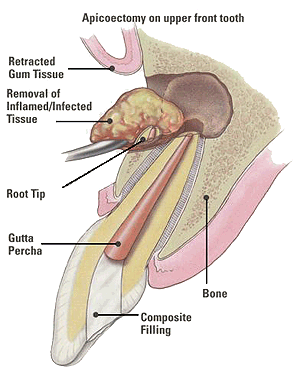
The most common endodontic surgical procedure is called an apicoectomy or root-end resection. When inflammation or infection persists in the bony area around the end of your tooth after endodontic treatment, your endodontist may perform an apicoectomy. In this procedure, the endodontist opens the gum tissue near the tooth to expose the underlying bone, and the infected tissue is removed. The very end of the root is also removed, and a small filling may be placed to seal the root canal. Local anesthetics make the procedure comfortable, and most patients return to their normal activities the next day.
What are the alternatives to endodontic treatment?
When the pulp of a tooth is damaged, the only alternative to endodontic treatment is extraction of the tooth.To restore chewing function and to prevent adjacent teeth from shifting, the extracted tooth must be replaced with an implant or bridge.This requires surgery or dental procedures on adjacent healthy teeth and can be far more costly and time-consuming than endodontic treatment and restoration of the natural tooth.
No matter how effective modern tooth replacements are—and they can be very effective—nothing is as good as a natural tooth.
For More Information
If you would like further information about endodontic treatment, your endodontist will be happy to talk with you, or you may write to the American Association of Endodontists.
American Association of Endodontists
211 East Chicago Avenue, Suite 1100
Chicago, Illinois 606l 1-2691
800/872-3636 or 312/266-7255
www.aae.org
